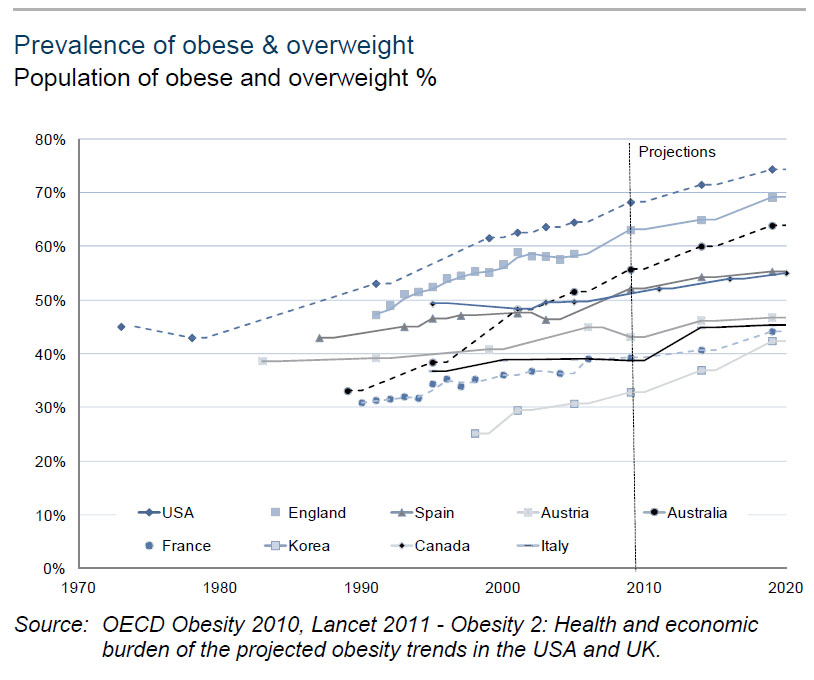(ZeroHedge, Nov 24, 2012): Back in March, we first presented a rather stunning finding: by 2020 75% of Americans will be obese or overweight. This was promptly followed up with a post showing just how it is transpired that America became the fattest nation in the world in less than 20 years. What however may not be known, is that America’s fatness epidemic is not localized to the country that gave the world the McDonalds burger (and the McMansion): it really is a fat, fat world, after all. Behold – survival of the fattest:
It is hardly surprising in this light, then, that the estimate for number of people living with diabetes has been increased, to 371 million – an increase of 11% over 2011.
So with the sensitive issue of what one stuffs in their mouth becoming of paramount importance, primarily due to the avalanche in social costs as a result of escalating morbid obesity, here is a primer on the key facts and figures relating to obesity, domestic as well as foreign, and impacting not just the developed world but also emerging economies, from GS’ Mick Ready and Keyur Parekh.
Obesity is a unique phenomenon affecting almost all countries. It is defined as excessively high amount of body fat in relation to lean tissue, and individuals are generally considered overweight if their BMI is over 25, and clinically obese if their body mass index (BMI) is greater than 30.
The 1980s saw a sharp acceleration in BMI in OECD countries. Before 1980, global obesity rates were generally below 10% but today, in almost half of OECD countries, 50% of the population is overweight. Interestingly, data suggests that obesity is a pandemic that is now impacting not just the developed western countries, but also the emerging economies. In BRIC economies, obesity rates are somewhat lower than in their OECD counterparts, but urbanisation and lifestyle changes are driving a significant increase in average BMI. In China, the proportion of the population considered overweight increased from 13.5% in 1991 to 26.7% in 2006; in Brazil between 1975 and 2003, the obesity rate tripled in men and doubled in women; and in Russia 25% of women and 10% of men are now considered obese.
- Data suggest that at levels of GDP below US$5,000 per capita there is a linear relationship between GDP and mean BMI, and that the only pre-condition for developing an obese population is the ability to afford food.
- In low income countries, obese individuals are typically middle-aged women from wealthy, urban settings.
- In countries with GDP of more than US$5,000 per capita pa, obesity is not characterized by gender, or age, but disadvantaged groups typically are at greater risk of becoming obese;
- 33% of US adults earning over US$15,000 pa are obese, compared with 25% of those earning over US$50,000 pa.
- 33% of adults who did not graduate high school were obese, compared with 21.5% who graduated from college.
What’s causing this increase?
Obesity is a complex problem, with multiple factors influencing its development within a population. These factors include systemic and environmental drivers, which provide an infrastructure to promote high growth, consumption of transport and recreational factors, which limit the physical activity within a population, and behavioral patterns, where individuals consume high-energy foods and lead sedentary lifestyles.
For an individual, obesity is caused by an energy imbalance: simply put, obese individuals consume more energy than they use. Energy intake is a clear factor in the rise of obesity, and dietary intake is strongly influenced by the kinds of food we eat. Changes in the food system to more mass-produced, processed foods with added salt, fats and sugars, coupled with more effective marketing of these products, especially targeting young children has changed the kind of food we eat which contributes to this energy imbalance.
To summarize, changes in the global food system, which produces readily available, inexpensive, highly processed and well marketed foods, coupled with changes in working patterns, has created an energy imbalance resulting in increased levels of obesity.
Sugary drinks: The choice of a heavy generation
There are multiple factors which are linked to the development of obesity globally, but sugar-sweetened drinks have attracted particular attention in the US. Sugar intake from sugar-sweetened drinks is thought to be the largest single caloric food source in the US, approaching 15% of the daily calorific intake in several population groups.
